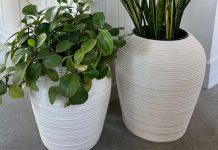
Rain gardens come in all shapes, sizes, colours, and textures, yet they share a few common features: a shallow bowl, gently sloped berms, and clear inlets and outlets for water.
The people who tend them also vary — different homes, neighbourhoods, and gardening goals — but they often share a bright smile when talking about their gardens and the joy they bring.
GreenUP partners with the City of Peterborough in delivering the Rain Garden Subsidy Program. The pilot project, ending this fall, offers eligible residents up to $1,000 to offset the cost of design and installation of a rain garden.
This summer, GreenUP visited a few local rain gardeners to see how their landscapes are blooming.
Elaine Day: Helping veggies with a side of pollinators

Elaine Day is an avid vegetable gardener in Peterborough’s east end. Her terraced garden sits on a sun-soaked slope that helps her veggies grow, but also dries out the soil quickly.
To tackle this, Elaine installed a rain garden which helps keep soil moist by slowing and absorbing water instead of letting it rush away as runoff. Moist soil improves water retention, meaning more water is available to all plants — even during dry spells.
“My main reason was to help my vegetables,” Elaine says of the reason she installed a rain garden. “But now I love watching it come to life in the spring and seeing all the pollinators it attracts.”
Her garden now bursts with colour from native plants like Black-eyed Susan, Wild Bergamot, and New England Aster.
Elaine’s rain garden tip: “It takes a lot of digging, but it’s totally worth it.”
Robert Brown: Water harvesting and low maintenance

Robert Brown lives on a corner lot in the west end of Peterborough, where he’s been steadily replacing his lawn with gardens. He’s motivated by both aesthetics and function.
“I don’t want to spend my time cutting grass, but time in the garden is always a pleasure,” he says.
His yard slopes toward the street, so he placed his rain garden at the top, where it can catch and slowly release water into the rest of his garden. He combines this with additional rainwater harvesting, directing overflow from a rain barrel into the garden.
Robert also applies rain garden strategies like berming in other parts of his garden. Around his tomato plants, small berms hold water in place, helping it soak in slowly to where roots need it most. It saves time and conserves water.
Robert’s rain garden tip: “Just dig in and do it … then keep experimenting.”
Sheila Holliday: Curb appeal and constant discovery

Sheila Holliday didn’t build her rain garden — it came with her house.
“When I was house hunting, the little rain garden out front caught my eye,” she says. Already an experienced gardener, Sheila loved the idea of a native plant garden designed to manage stormwater. Since moving in, she’s made it her own.
“Some plants prefer the edge of the berm, like Dense Blazing Star and Nodding Onion,” says Sheila. “It’s a process of discovery to find plants that thrive in the wetter parts of the bowl. I’m currently trying Foxglove Beardtongue, False Indigo and Cardinal Flower.”
Sheila also experiments with colour and height through the seasons. In early spring, Prairie Smoke adds a soft texture at the front of the garden. By midsummer, it’s bursting with the yellows of False Sunflower and the purples of Wild Bergamot and Purple Coneflower. Come August, Great Blue Lobelia and Flat-top Aster take over with cool blue and white tones.
“I love that people stop and ask about it,” she says. “It’s unique, and it’s always changing.”
Sheila’s rain garden tip: “I encourage others to take advantage of the city’s rain garden subsidy and have fun experimenting.”
Rain gardens are more than beautiful: they reduce flooding, filter stormwater, support pollinators, and add curb appeal. They’re also a great way to learn about local ecology. Native species like Canada Anemone, Wild Columbine, and Joe-Pye Weed not only thrive in our region’s conditions, they also provide food and habitat for birds, bees, and butterflies.
Peterborough’s Rain Garden Subsidy Program, offered through GreenUP and the City of Peterborough, helps residents with the cost of materials and expert advice to get started. With a bit of space and curiosity, residents can enjoy a rain garden that gives back in many ways: providing exercise, beauty, habitat, and climate resilience — all in one.
For rain garden resources — including step-by-step guides and videos on how to get started — and to apply for the City of Peterborough Rain Garden Subsidy, visit greenup.on.ca/rain-garden-subsidy-program. The subsidy is open to residents of Peterborough until later this fall, and is awarded on a first-come first-served basis.


























